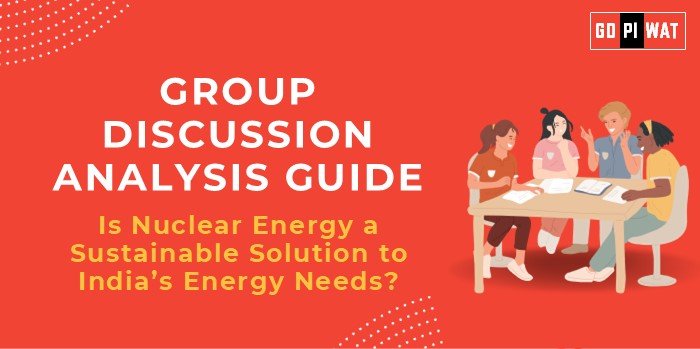📋 Group Discussion (GD) Analysis Guide
⚛️ Is Nuclear Energy a Sustainable Solution to India’s Energy Needs?
🌟 Introduction to the Topic
- 🌍 Opening Context: With India aiming for a net-zero target by 2070 and growing energy demands, nuclear energy is emerging as a significant contender in the renewable energy mix. The debate focuses on whether it is sustainable, safe, and viable in the Indian context.
- 📜 Topic Background: India has 22 operational nuclear reactors contributing about 3% to its electricity needs. The government aims to triple this capacity by 2031. Nuclear energy is often debated for its sustainability due to concerns about waste management, safety, and high initial costs.
📊 Quick Facts and Key Statistics
- ⚡ India’s Nuclear Capacity: 6,780 MW from 22 reactors (2023).
- 📈 Planned Expansion: 21 more reactors to generate an additional 15,700 MW.
- 🌍 Global Nuclear Contribution: Supplies about 10% of global electricity needs.
- 🍃 Carbon Footprint: Near zero during operation, making it a clean energy source.
- ⛏️ Uranium Reserves: India relies on imports due to limited domestic reserves.
🤝 Stakeholders and Their Roles
- 🏛️ Government of India: Policy formulation, funding, and international collaborations.
- ⚙️ NPCIL: Reactor construction and operation.
- 🌐 International Organizations: IAEA ensures safety and non-proliferation.
- 🌱 Environmentalists and NGOs: Advocate for renewable alternatives or highlight safety concerns.
- 👨👩👧👦 Local Communities: Often impacted by displacement or environmental risks from plants.
🏆 Achievements and Challenges
Achievements:
- 🔒 Energy Security: Reliable base-load power unaffected by weather.
- 🍃 Carbon Reduction: Helps meet climate goals.
- 🔬 Technological Advances: Indigenous reactors like the Pressurized Heavy Water Reactor (PHWR).
Challenges:
- 💸 High Costs: Initial investments and long construction times.
- ⚠️ Safety Concerns: Risks of accidents like Chernobyl and Fukushima.
- 🗑️ Waste Management: Long-term storage issues for radioactive waste.
Global Comparisons:
- 🇫🇷 France: 70% of electricity from nuclear; strong waste management systems.
- 🇩🇪 Germany: Phasing out nuclear due to environmental concerns.
Case Study:
- 📍 Kudankulam Nuclear Power Plant: Largest nuclear facility in India, plagued by delays and protests.
🗣️ Structured Arguments for Discussion
- ✅ Supporting Stance: “Nuclear energy offers a clean, reliable power source essential for India’s growing energy needs.”
- ❌ Opposing Stance: “The risks and costs of nuclear energy outweigh its benefits, especially when renewable alternatives are advancing.”
- ⚖️ Balanced Perspective: “Nuclear energy, if managed sustainably, can complement renewables to meet India’s energy goals.”
💡 Effective Discussion Approaches
Opening Approaches:
- 📊 Data-Driven: “With 22 reactors and plans for 21 more, India is at a crossroads in its energy strategy.”
- 🌍 Global Context: “France demonstrates the feasibility of nuclear power; Germany highlights the risks.”
Counter-Argument Handling:
- ✔️ Acknowledge risks and present advancements in safety protocols.
- 💡 Emphasize the complementarity of nuclear and renewable energy.
🧠 Strategic Analysis of Strengths and Weaknesses
SWOT Analysis:
- ✔️ Strengths: Stable energy output, low operational emissions.
- ❌ Weaknesses: High costs, limited uranium.
- 🌟 Opportunities: International collaborations, technological innovations (e.g., thorium reactors).
- ⚠️ Threats: Public opposition and accidents.
📚 Connecting with B-School Applications
Real-World Applications:
- 🌿 Project themes like “Sustainability in Energy Mix” or “Policy Design for Nuclear Waste Management.”
Sample Interview Questions:
- 🧐 “What are the risks of expanding nuclear energy in India?”
- ⚡ “How does nuclear energy align with India’s climate goals?”
Insights for B-School Students:
- 📊 Understanding risk management in large-scale projects.
- 🌱 Exploring energy policy as a case for sustainable development.


